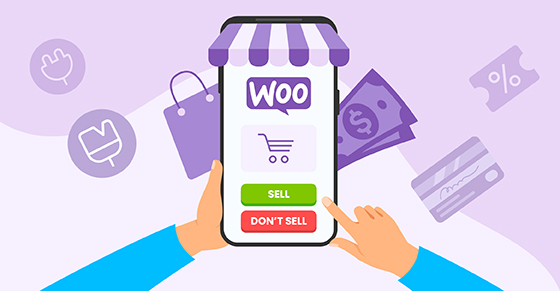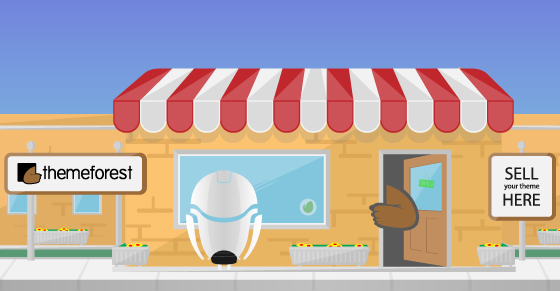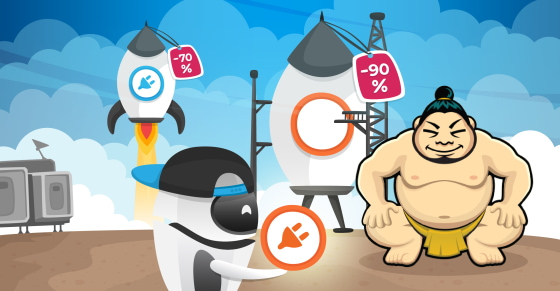|
|
It’s a WordPress tale as old as time (well, at least since monetization became popular). You’ve hit on a great idea for a plugin that fills an underserved niche. You want to monetize it and potentially build a business around this core offering. Or, maybe you’re a seasoned maker who wants to launch a new plugin to raise awareness about your business and its suite of products.
The pressing question: How do you generate visibility and traction to build much-needed early momentum for your new product?
Enter WordPress marketplaces.
One of the most popular ways to boost a young product is to list on the aforementioned platforms, where much of the administrative heavy lifting is taken care of for you — billing, traffic, sales handling, promotion, etc.
It’s a logical conclusion, then, that many developers will gravitate to the most well-known of them all: the WooCommerce Marketplace. This heavily trafficked hub commands a large ecosystem influence and holds a solid reputation in the community, boasting a highly relevant, primed audience with intent to purchase.
But in the modern WordPress era, where developers seek more control over their products and a bigger share of their well-deserved revenue, is this business model still viable for product makers? To get to those answers, I’m diving head-first into the WooCommerce Marketplace to explore its history, the platform itself, and the benefits and disadvantages that come with selling extensions on it.
Oh, and did I mention that I received some help from our maker with firsthand selling experience on the platform?
Table of Contents
-
- What Is WooCommerce?
- What Is the WooCommerce Extensions Marketplace?
- What Opportunity Does the WooCommerce Marketplace Offer Developers?
- Which Categories Are Earmarked for Growth?
- What Does the Geographical and Pricing Distribution Look Like?
- How Many Extensions Are on the WooCommerce Marketplace?
- What Do the Pricing Tiers Look Like?
- How Many Themes Are on the WooCommerce Marketplace?
- How Big of a Business Can You Build on the WooCommerce Marketplace?
- What Revenue Share Cut Does the Marketplace Take?
- Quickfire Answers to Important WooCommerce Marketplace Questions
- Why Selling Extensions on the WooCommerce Marketplace Is a Good Idea
- Why Selling Extensions on the WooCommerce Marketplace Is a Bad Idea
- What’s Your Next Move?
What Is WooCommerce?
WooCommerce is a free, open-source eCommerce plugin for WordPress. Before WooCommerce there was WooThemes, a company founded by Adii Pienaar, Magnus Jepson, and Mark Forrester (a fellow South African!) in 2008. In a time when WordPress themes were mostly used for blogging, the company pioneered the model of ‘theme modularity’, whereby they shifted theme functionality into plugins (AKA “extensions”) to make their products clean, lightweight, and customizable.
Around that time, the makers at WooThemes took noticeable first steps into the burgeoning online merchant arena. Their decision to tackle eCommerce culminated in the fork of an existing plugin to gain a foothold. And while WooThemes was within its rights to do so, the way it was handled is still considered to be somewhat controversial.
Spotty past aside, WooCommerce was officially launched in September 2011 as a free core product and became an immediate hit with one million+ downloads in under two years (626 days to be precise). Very quickly, it reached seven million downloads and was powering approximately 30% of all online stores.
A remarkable share of the growing eCommerce landscape that did not go unnoticed. In 2015, heavyweights Automattic acquired WooCommerce and its 55-strong staff, along with WooThemes and its products, for a reported US$30 million.
Automattic, and by default Matt Mullenweg, have big plans for WooCommerce this year. At Matt’s annual keynote address, he stated that the Automattic team wants WooCommerce to do for eCommerce what WordPress did for publishing. That is spearheading democratization in a way that platforms like Shopify can’t.
In combination with better Gutenberg compatibility, the tip of that WooCommerce spear thrusting into the future is (in my opinion) the extensions marketplace and its expanding stable of products.
What Is the WooCommerce Extensions Marketplace?
The WooCommerce Marketplace is a hub on which developers can list extensions and themes for users to build online stores on the back of the WooCommerce plugin.
The marketplace’s remarkable success is due in large part to the pioneering model of selling extensions as paid add-ons. It was the natural choice in hindsight — paid add-ons ensured that WooCommerce could harness the broad scale of eCommerce and its many potential iterations and integrations.
But how to expand this then-young marketplace?
At a certain point, Automattic opened up the WooCommerce Marketplace to third-party developers to bolster the platform’s inventory. These makers were invited to sell their extensions under a rev-share agreement, while still handling customer support themselves. Rather erratically, the marketplace was closed, then reopened, and sometimes not accepting new third-party developers at all.
There isn’t much information as to what caused the indecisiveness, but if I had to guess, perhaps it was a matter of resources? New extensions need to be reviewed for quality, developers have to be vetted to ensure they’re qualified, support staff needs to be trained, etc.
Eventually, however, the marketplace was kept open and third-party makers had a critical business choice to make. Having adopted an exclusivity model similar to Envato’s CodeCanyon and ThemeForest, developers had to decide whether they would:
- Sell exclusively on WooCommerce for a greater cut of the profits.
- Sell on WooCommerce and other websites and have a sizable amount of revenue go to the marketplace.
If a developer chose the non-exclusive route that meant higher fees for them. Additionally, the marketplace blocks competition which isn’t very good for makers who want their products distributed to as many people as possible via multiple channels.
Fast forward to 2022 and the WordPress ecosystem has changed dramatically. As mentioned, we contacted several software makers for feedback on their experiences with the WooCommerce Marketplace. Except for Marius Vetrici and Andrei Haret, co-founders of Subscription Force, all of our contributing makers requested to remain anonymous. Their opinions are balanced, nuanced, and offer a window into the inner workings of the marketplace, all of which should help you decide whether it’s right for your product.
What Opportunity Does the WooCommerce Marketplace Offer Developers?
With a tally of 170M+ downloads and 5 million+ websites using it, WooCommerce is the most popular eCommerce platform in the world. Currently, 8.9% of all websites use the plugin and it sits just behind Squarespace in terms of market share with 23.43% and 23.51% respectively (according to this 2021 survey). Another compelling statistic is that WordPress.org supports the plugin in 66 languages — cementing its global reach and accessibility.
The WooCommerce Marketplace itself is hosted on the TLD woocommerce.com. Because Google and other leading search engines “see” the website as the authority on all things WooCommerce, people searching for WooCommerce extensions will probably be served up links to products on the marketplace as first items on SERPs.
So who are the users, where are they best represented, and what are the needs that drive this opportunity? The official overview states:
- 84% of customers are buying extensions for their own stores.
- The top verticals by store volume are Fashion and Apparel, Health and Beauty, Electronics, Food and Drink, and Design and Marketing Services (spread across extensions and themes).
- The strongest representation is currently in North America, Europe, and Asia.
Which Categories Are Earmarked for Growth?
A critical part of product development is identifying customer needs that are underserved or not being met at all. For the WooCommerce Marketplace specifically, this means browsing its inventory to identify areas of opportunity in as-of-yet unsaturated categories.
The WooCommerce team is more likely to approve products that ‘are well-designed, add entirely new functionality, or serve specific audiences in new ways’ in growing categories with minimal to no inventory, specifically:
- Cryptocurrency
- Dropshipping
- Fraud prevention
- International and localization
- Policy and security
- Product images and media such as augmented/virtual reality
- Reporting and analytics
- SaaS
- SEO and SEM
- Themes
It’s interesting to note that the overview states: ‘Payments is our most popular category. We’re not currently looking for new payment gateway extensions. We are also not looking for additional solutions in the shipping, email or tax categories’. That statement outright tells you what not to submit to the marketplace (for now) so your best bet is to hone in on one of the listed categories above.
What Does the Geographical and Pricing Distribution Look Like?
Tinkering with the country filtering options on the extensions marketplace might not yield the most accurate results if you’re looking for extensions developed in certain countries vs. for exclusive use in certain countries.
What I did do was select the ‘big five’ locations that use WordPress to see how many extensions were either developed there or cater to customers in that market. It’s interesting to note that when filtering by rating, the ‘1 ⭐and up’ option includes products that are unrated as well as ones that fit into the ‘3 ⭐⭐⭐ and up’ category. For this reason, I’ve only included the highest rating in the below information. Also, because the Payments category holds the most products across the board, I’ve included the category with the second-highest extensions in the graph below.
Here’s what the product distribution by country looks like:
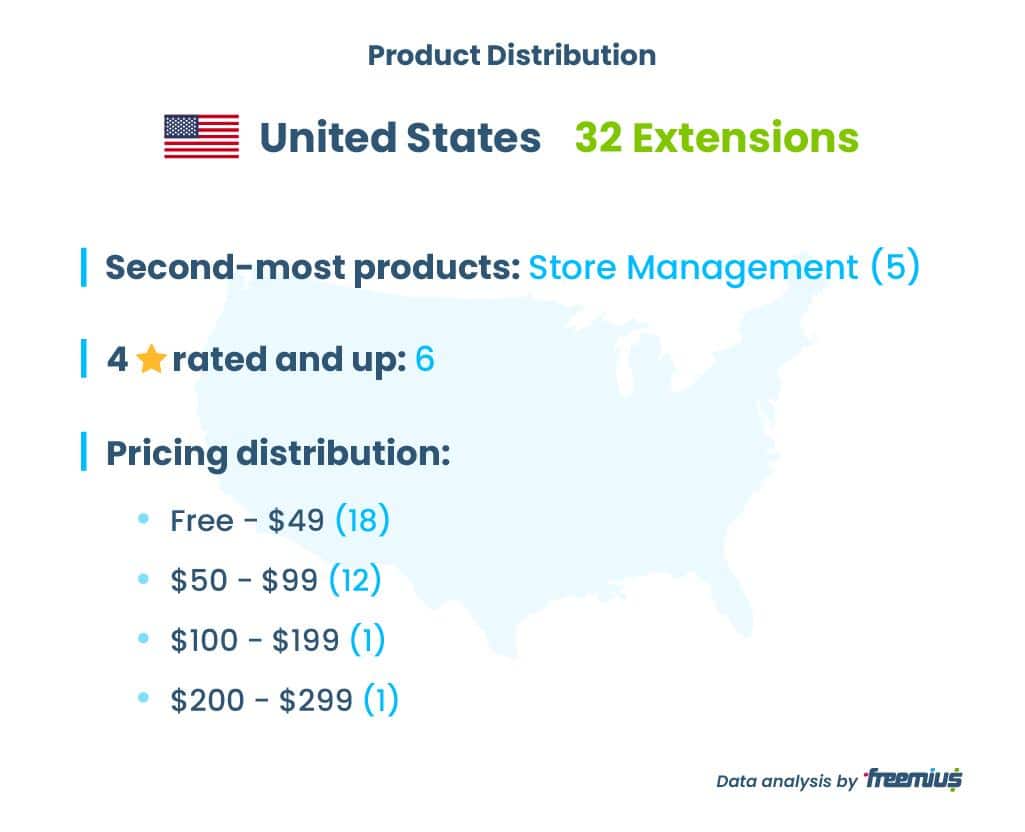
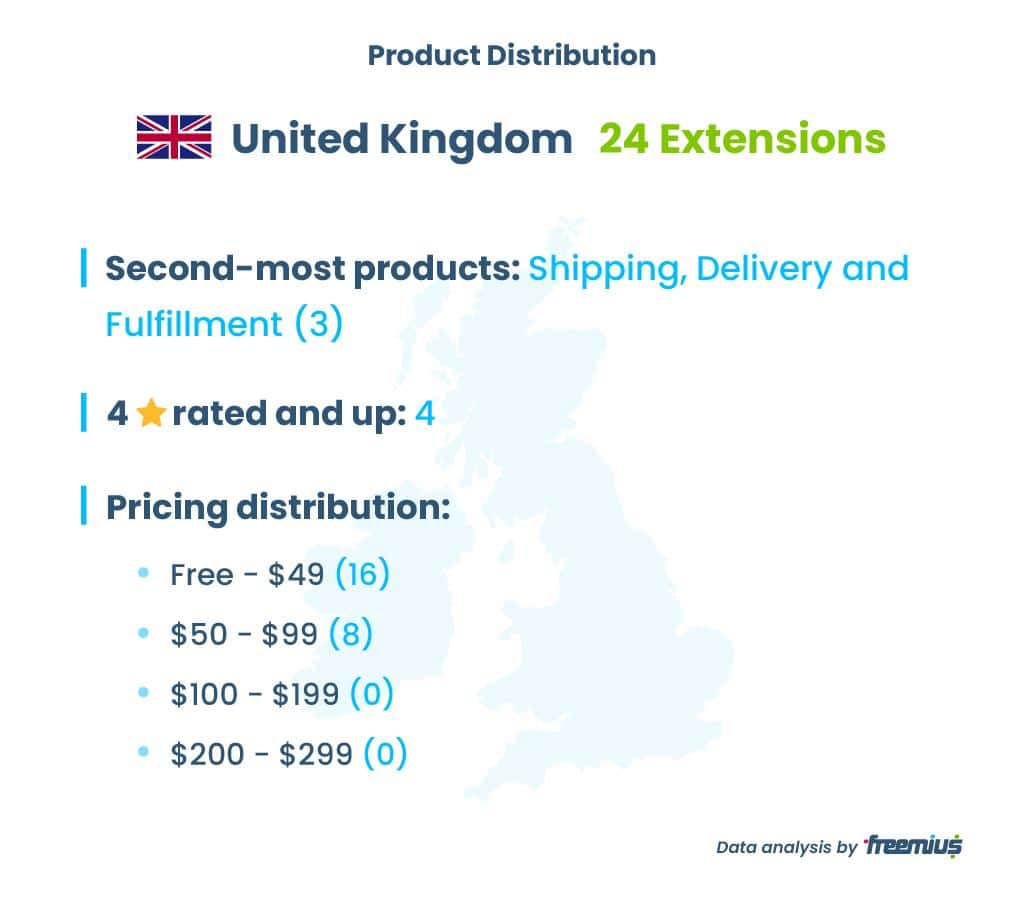
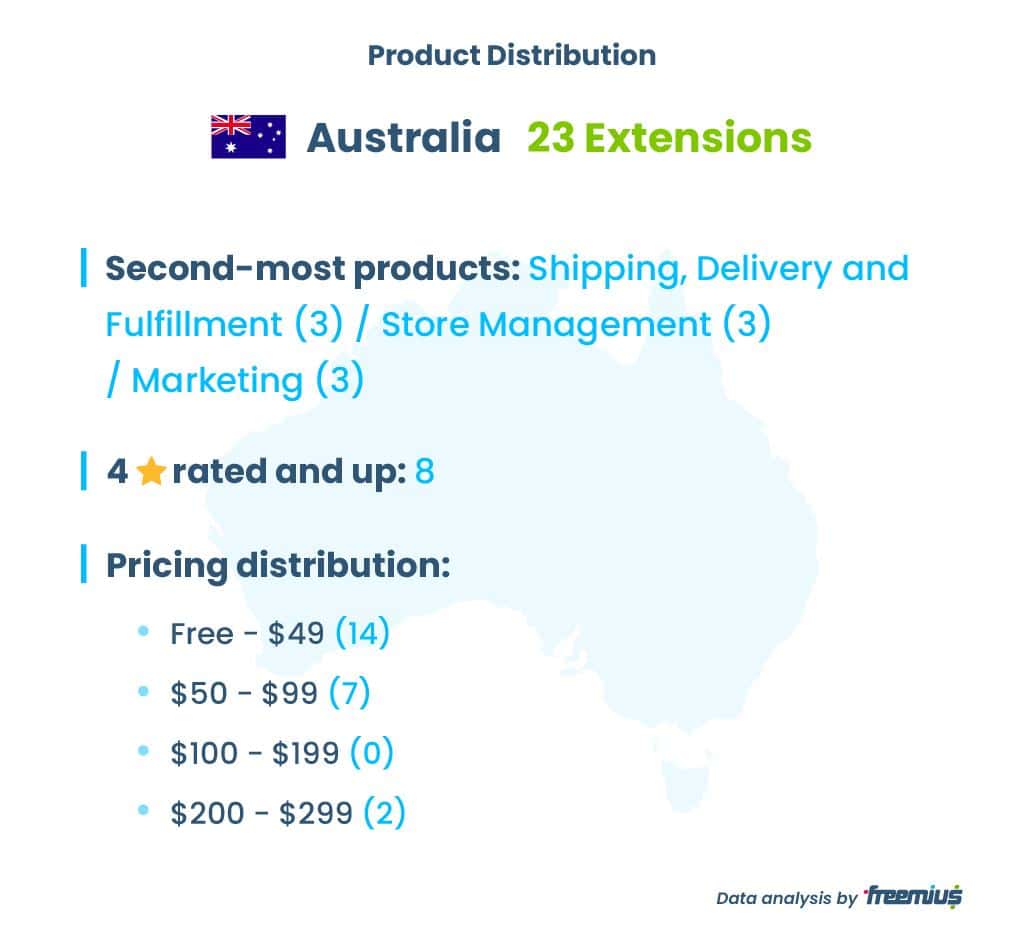
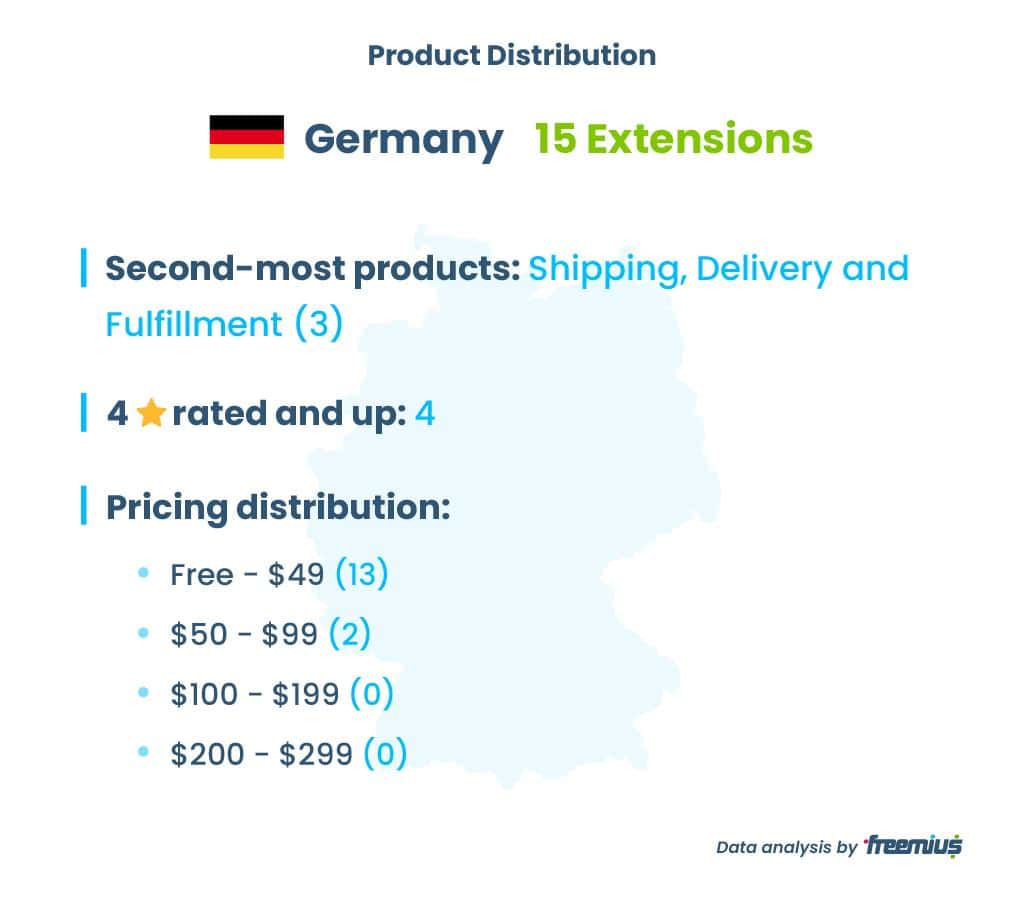
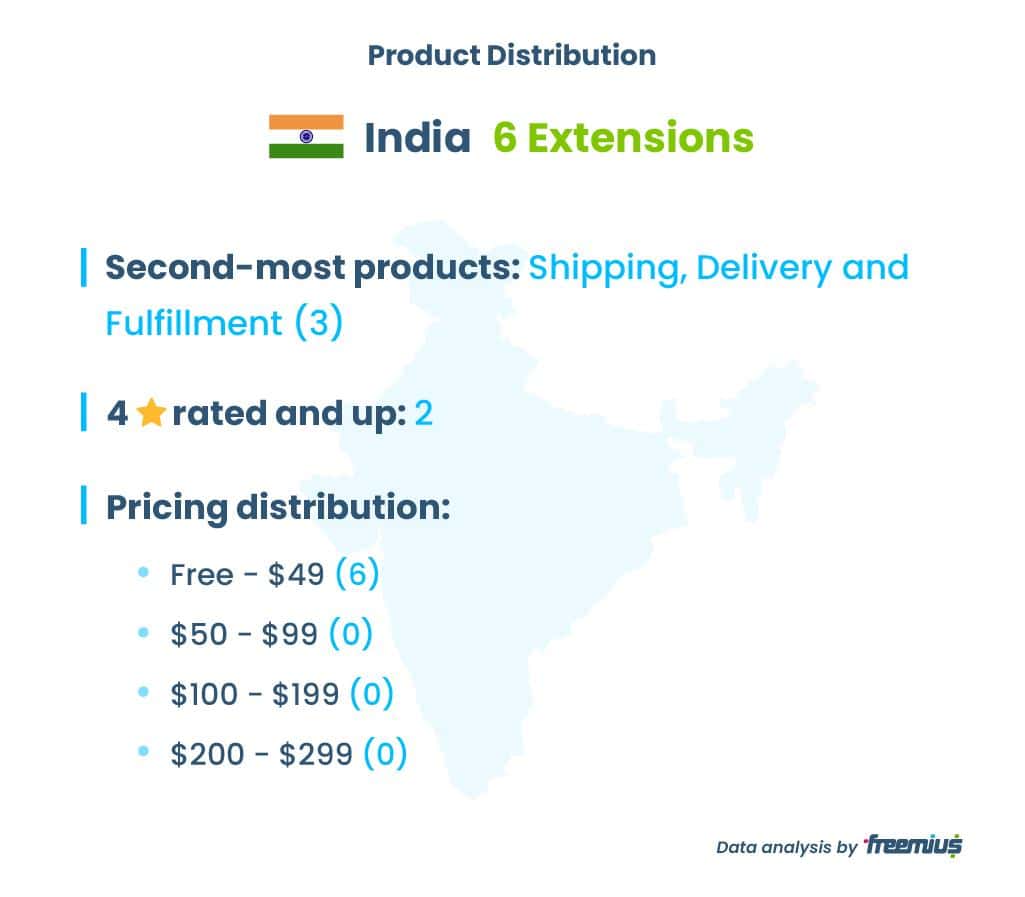
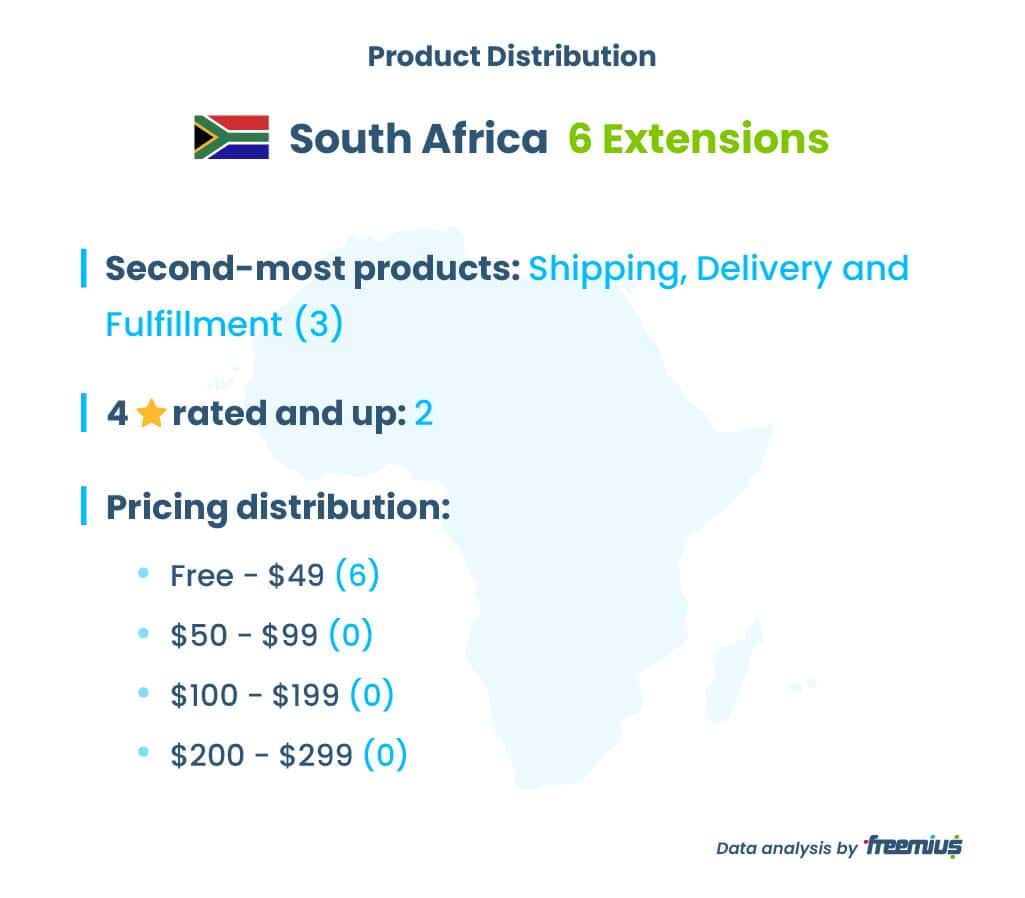
South Africa is my addition because we have a solid community here and it’s considered to be a growing market 😉
Note: the marketplace overview stipulates that North America, Europe, and Asia currently have the strongest representation. They add that ‘focusing on developing products that meet the unique needs of niche/local markets can be a great strategy. We’re specifically looking to better serve countries outside of the U.S. where WooCommerce has a substantial presence’. These locations are:
- Africa: South Africa
- Asia: India, Iran, Malaysia, Turkey, and Vietnam
- Europe: France, Germany, Italy, The Netherlands, and Spain
- North America: Canada and Mexico
- South America: Brazil
- Non-English submissions, with current priorities being Spanish, French, and Portuguese languages
The above information should be of use if you’re looking to get a foothold in growing markets that have WooCommerce’s (and thus Automattic’s) support.
Quick, relevant pro tip before we move along:
Having sold Self-service Dashboard for WooCommerce Subscriptions on the marketplace since March 2021, Marius Vetrici and Andrei Haret had this pricing advice to share:
‘You can also define your own custom prices for plugins. Initially, you get a drop down with some preset values; but if you reach out to Woo support, they’ll add your custom plugin price.’
How Many Extensions Are on the WooCommerce Marketplace?
A quick glance shows that there are currently 751 official extensions on the marketplace. Just 85 of them are ‘Developed by Woo’, which gives third-party developers the majority of listed products with 666. In terms of inventory, the extensions are split across 11 categories (if you include ‘All Extensions’) with 8 of them segmented into sub-categories. The inventory is split as follows:
- Marketing: 153 extensions
- Store Management: 102 extensions
- Developed by Woo: 85 extensions
- Payments: 80 extensions
- Merchandising: 77 extensions
- Conversion: 73 extensions
- Store Content and Customizations: 65 extensions
- Shipping, Delivery and Fulfillment: 60 extensions
- Free: 41 extensions
- Customer Service: 21 extensions
What Do the Pricing Tiers Look Like?
There are four pricing tiers and they range from free to $299. Here’s what the split looks like:
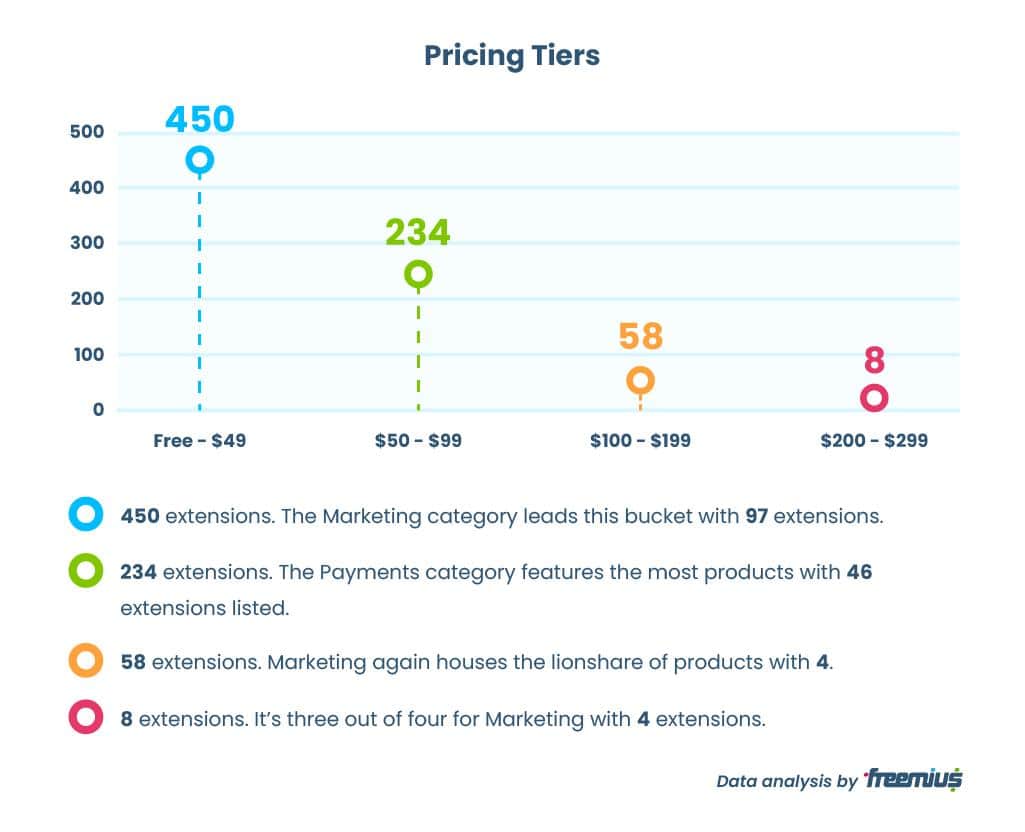
How Many Themes Are on the WooCommerce Marketplace?
Clicking on the Themes section makes it clear where the marketplace’s bread and butter lies (spoiler alert: it’s with WooCommerce extensions!). There are currently just 45 themes on the marketplace with 30 by third-party developers and 15 by WooCommerce. Themes are categorized by:
- Free: Just three themes here, including WooCommerce’s official theme Storefront.
- Storefront Themes: 14 themes, all of which are child themes designed by WooCommerce.
- Responsive: 35 themes of which the majority is built by third-party vendors.
The filtering options are rather sparse here — you won’t find pricing tiers, price filtering options, or country pickers. But having gone through each theme, I’ve identified these pricing points:
- Free
- $39
- $59
- $69
- $79
- $99
- $129 (it’s worth noting that the highest theme pricing tier is well below the extensions’ $299 price point)
The marketplace’s theme inventory is further divided by ‘Industry’, with Fashion and Apparel offering the highest number of themes — 17. Broken down by category, this is how the distribution looks:
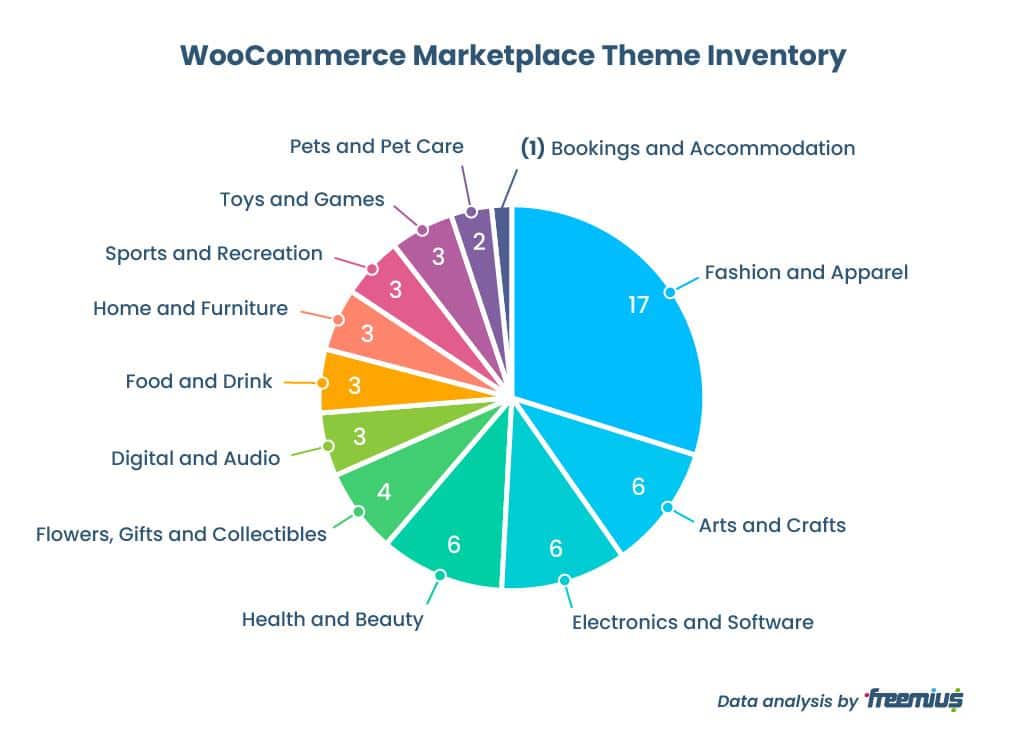
My two cents: With the themes market in decline as Full Site Editing takes center stage across the WordPress ecosystem, it’s probably not the best use of your time and talents to venture into the world of WooCommerce themes.
How Big of a Business Can You Build on the WooCommerce Marketplace?
While actual numbers are hard to come by and it’s difficult to find information on the top sellers, we can pinpoint certain companies that have achieved huge success on the WooCommerce Marketplace. Before I get into specifics, the marketplace home page does have ‘Most Popular’ and ‘Discover Our Favourites’ sections which should give an understanding of which extensions are leading the pack and which the marketplace is betting on.
Right, back to specifics!
If your listed extension builds enough of an audience and fills a niche that generates high sales, you have the makings of a successful business that will probably see you hiring staff to meet demand. Moreover, a healthy revenue stream and proven business growth bring outside parties to the table, which can lead to an eventual acquisition.
This is what happened to Prospress, the makers of WooCommerce Subscriptions. According to Post Status, the product was the highest revenue extension in the WooCommerce marketplace at the time, a fact that convinced the Automattic team to step in and acquire the business and its stable of products in 2019.
Paul Maiorana, WooCommerce’s CEO, told Post Status:
‘Subscriptions is an important differentiator for WooCommerce amongst eCommerce platforms, and we’re really excited to now be working closely with the Prospress team to create a more unified experience.’
Prospress was by no means a tiny start-up business either and part of the company’s success can definitely be attributed to the marketplace. At the time of the acquisition, the employee headcount sat at around 20 people and they had several other successful projects on the go. This was a company that was no doubt seeing annual revenue in the multi-millions.
Automattic saw the WooCommerce Subscriptions extension as an integral part of their future plans, and instead of developing/forking their own version, they chose to embark on the acquisitions process (a subject we recently explored for The Gamechangers video series). Now we don’t have a clear idea of how the discussions went on behind the scenes, but this event does illustrate how large and successful a business can get on the back of WooCommerce. If we go with the assumption that the acquisition was lucrative for all involved, it shows that it’s possible to turn a huge profit by leveraging the WooCommerce Marketplace.
I go into further detail about the acquisitions power the WooCommerce team wields — for good or bad — further along in this piece.
What Revenue Share Cut Does the Marketplace Take?
Up until a few months ago, the WooCommerce Marketplace took a sizable cut of a developer’s earnings. One of our anonymous product developers remarked:
The fees are VERY high. They take 60% of our earnings because we sell on our own site as well. Normally they would take 40%, which is still very high.
The above sentiment is echoed in a statement from another of our interviewees, with the caveat that their experience is from a few years ago.
‘…the high commission charged by the marketplace can make it hard for a developer to earn a good living. The amounts paid by the marketplace could be good for teams living in cheap countries, but one would have to produce a huge amount of sales to fund an equivalent team in locations like Western Europe, or North America.’
At the risk of generalizing, I’d say a good chunk of developers getting into the plugins market today sell from their own stores first, and not on a multi-vendor marketplace. Before things changed, makers that shifted over to the WooCommerce Marketplace would have lost somewhere between 50 and 60 cents per dollar. Less if they didn’t sell from their own store and listed the extension exclusively on the marketplace, which meant missing out on other revenue channels.
This has since changed and WooCommerce has removed exclusivity and dropped its commission to 30%:
Partners earn 70% of net revenue for the sale of their non-exclusive products, meaning the products can be sold on our Marketplace as well as off-platform. “Net revenue” applies to products sold in our Marketplace and means all revenues received by us in connection with a customer’s subscription for the product, less any amounts for discounts, refunds, reversals, affiliate fees, payment processing fees, and taxes. Payments are sent within 30 days of the end of the month.
Whether in response to Shopify’s decision to drop commissions to 0% or bowing to the pressure of increased calls for fairer fees, we’ll never know. But it does show that the WooCommerce team is willing to listen to and implement feedback on improvements.
It also points to a larger shift in the landscape, whereby developers are making their voices heard for a fairer share of revenue and control.
Quickfire Answers to Important WooCommerce Marketplace Questions
Does the WooCommerce Marketplace Offer a Subscriptions Model for Extension Developers?
Extensions on the WooCommerce Marketplace are sold as yearly subscriptions with a 30-day money-back guarantee. For SaaS products or similar, you can opt for listing free extensions with a monthly subscription outside of WooCommerce.com.
How Are Updates and Support Handled for Extensions Sold Through the WooCommerce Marketplace?
Marius Vetrici informed us that:
‘It works pretty smoothly; we upload a new version in the Woo backend, then existing customers can upgrade to the lastest version. And all new customers will get the lastest version. Support tickets come directly to our mailbox, which is now connected to a Ticketing tool, and we handle the tickets directly.’
Marius was also kind enough to share a screenshot of the update process:
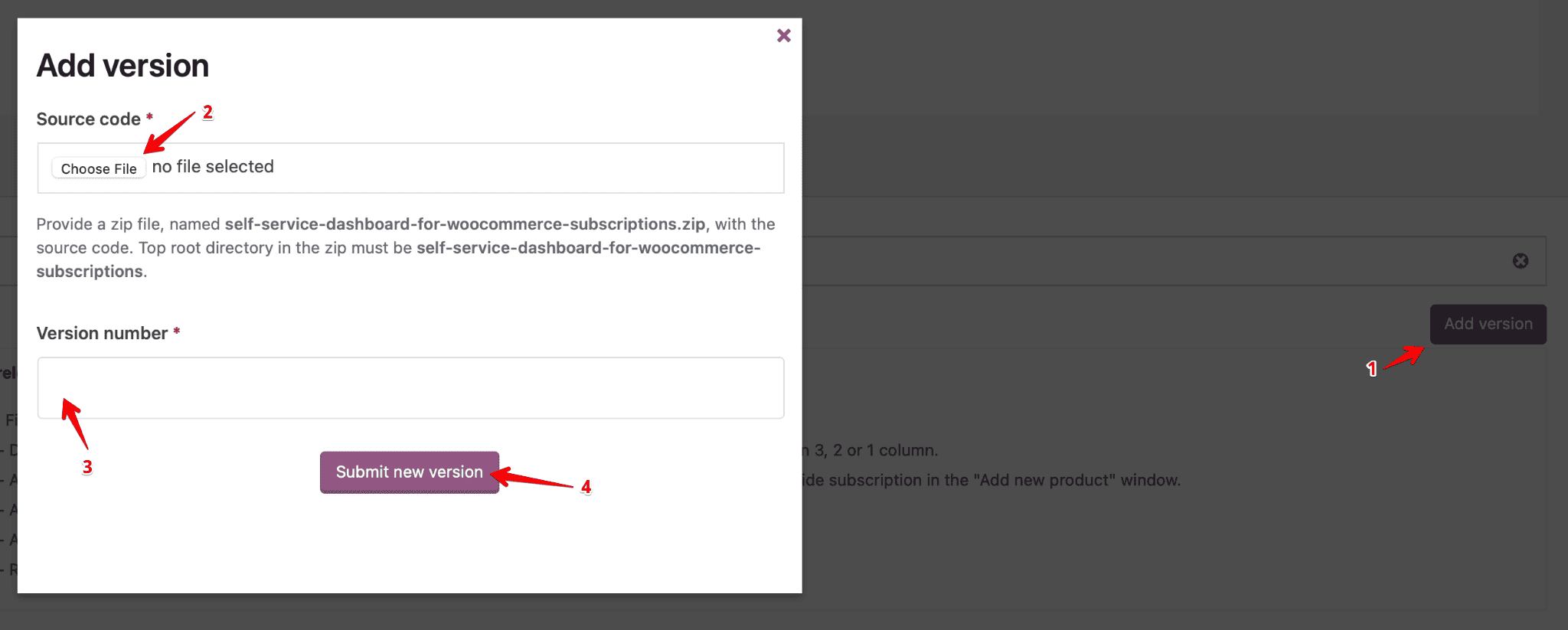
How Do Payouts and Billing Work and Does the WooCommerce Marketplace Calculate Taxes?
WooCommerce adds the correct taxes from each sale based on the buyer’s location and includes relevant info (such as whether the area has a valid VAT code). Developers then receive revenue in the form of monthly payouts to their bank accounts. The Partnership Agreement states: ‘We will pay you the Product Revenue Share on a monthly basis within 30 days of the end of each calendar month for which we receive the Product Net Revenue, subject to a minimum payout threshold amount of US$100.’ Marius and Andrei confirmed this:
‘The payouts are very good in WooCommerce. From what I know (I’m 98% sure about it), you get paid the next month for the money made in the previous one. So, in March we get the money for Feb. If there are any refund requests in March, they just deduct it from future payments. This is very convenient.’
Does the WooCommerce Marketplace Provide Customer Data Like Contact Info, User Metrics, or Sales Analytics?
No, it does not. Developers are privy to revenue, refunds, and the active subscriptions number. There are currently some efforts in the pipeline to let developers see the reasons for refunds but don’t expect to get access to customers’ contact info. This will probably never happen.
Does the WooCommerce Marketplace Have an Affiliate Program?
Indeed it does! The WordPress.com Affiliate Program helps affiliates promote WordPress.com, Jetpack, and WooCommerce to earn affiliate rewards. The initiative is currently limited to a select number of participants and operates on an invite-only basis to maintain high-quality service and revenue opportunities for affiliates. However, they do have a ‘WordPress.com Refer-a-Friend program that allows you to earn free account credits while allowing your network (friends, family, social media followers) to also benefit with a reward’.
Does the WooCommerce Marketplace Help Developers Overcome Visibility Challenges?
Yes. The team organizes entire marketplace discount campaigns for seasonal promotions like Cyber Monday + Black Friday. One of our makers stated that their ‘sales went up by 50%-70% during the promotion periods’.
There is also a dropdown option to sort by ‘new’ to see the latest extensions added by date. Unfortunately, everything the WooCommerce Marketplace does is centralized so there is currently no way for developers to define their own coupons or have their own affiliates.
Can Any Developer Apply to Sell Extensions on the WooCommerce Marketplace?
I couldn’t find any specific restrictions in the documentation. But since WooCommerce is an American company, they have to abide by the Trading with the Enemy Act of 1917 which restricts commerce between the United States and countries under sanction (such as Cuba). There is also a stringent reviews and submissions process and a Partnership Agreement that stipulates the terms and conditions of the contract.
Does the WooCommerce Marketplace Come With a Mechanism to License Your Extensions?
I can talk from personal experience here and say that the purchase and installation process is pretty slick. The sales landing page provided me with information about updates, support, documentation, as well as compatibility information.
Having already installed the WooCommerce plugin on a test site, I hit purchase on my plugin of choice and was prompted to install it from the post-purchase page itself. First, it had to sync with my website, and then the extension was automatically installed on my Admin Dashboard with no license key activation needed.
Still uncertain about the marketplace? Then I hope the below pros and cons aid your eventual decision:
Why Selling Extensions on the WooCommerce Marketplace Is a Good Idea 👼
‘Generally, the experience with selling on the marketplace is good.’ – Marius Vetrici
1. Tap Into the Right Audience at the Right Time and Place
The marketplace itself is accessible through the WP Admin Dashboard if you’ve got the WooCommerce plugin installed. This benefits both parties — developer’s extensions are given more exposure and users can browse the store without having to leave the comfort of the WP Admin Dashboard.
With the promise of increased visibility and promotion from the WooCommerce team, the marketplace is tempting for both new and experienced developers. The opportunity for exposure to a potentially huge and relevant audience is enough to sway those who are starting or struggling to find the traction needed to make a good living.
Undoubtedly, the WooCommerce marketplace is still the most relevant place for selling WooCommerce extensions.
2. Perceived Endorsement From the WooCommerce Team
When asked about the perks of WooCommerce, one of the developers we contacted had this to say:
‘Based on what I’ve seen, the official marketplace gives an appearance of endorsement from the WooCommerce team, which can boost sales. The WooCommerce team also promotes the products, reducing the marketing efforts.’
The fact that Automattic owns WooCommerce ensures that it stays top-of-mind by sheer virtue of having a (seemingly) bottomless budget. And, whatever your opinions on Automattic’s actions/decisions of late, having the backing of one of WordPress’s most influential companies lends undeniable credibility to the platform and the products on it.
3. Seed the Product, Test the Waters, and Drive Traffic
‘It’s good that you don’t need to focus on many aspects, like building the platform to sell on, generating traffic and sales, handling the billing, etc. You focus on finding the marketing fit, developing the product, positioning it right, and managing the support.’ – Marius Vetrici
Product makers can introduce new extensions to the marketplace and gauge interest before having to devote unnecessary time to development and marketing (such as building a website). Because the WooCommerce team handles billing and fulfillment, you won’t have to worry about anything other than the extension itself. If the interest is there, you’ll know that the product warrants your time. If it’s not, you can shelve it and move along.
Also, if you have a suite of products housed on a website, you could feasibly release a WooCommerce extension on the marketplace and use it to raise awareness about your business and products. That said, the terms state that you agree to ‘not display any link that leads to a third party site on either your Product Page or your Partner Page on the WooCommerce Site’. So this point relies on the user searching for your product and brand after the fact.
While these practices look good on paper, the review process to get into the marketplace may be more work than it’s worth (but we’ll get into that later).
Why Selling Extensions on the WooCommerce Marketplace Is a Bad Idea 😈
1. No Access to Customer Data
Understanding who your customer is and why they’re purchasing your product is an integral part of product and business development. It’s a pity, then, that WooCommerce’s purchase records are something of a ‘black box’ to developers who sell on the marketplace. By that we mean product owners aren’t privy to customer data and information, nor are they given a means of contacting their customers directly. Marius Vetrici had this to say on the matter:
‘The problem is you lose control and transparency:
- We are not sure who our clients are; we don’t have information on who bought the extension unless we received a support ticket from them.
- You can’t market yourself: not only do you not know who your clients are, but also you don’t have their contacts, so you can’t upsell, nurture or reduce churn.
- Also, it’s hard to promote the extension to cold leads because sending traffic to a marketplace is not very efficient. People might just jump to another competitive extension. Also, you can’t generate custom offers, etc. E.g., you are allowed to change the price only once per year, with the help of Woo support.’
2. You Can’t Use Your Licensing
A fundamental part of an efficient licensing system is being able to link it to customers — WooCommerce keeps this information bricked off from developers unless they create their own solution. As all payments go through the WooCommerce marketplace, cell integration with your own licensing system is exceedingly complex.
This also means you need to maintain two versions of your extension: one to sell on your website and another that’s been stripped of your licensing engine so that it can be listed on WooCommerce. Stripping these features from your extension is detrimental to your product because it removes some protection from your code.
3. It’s Not Your Branding
An additional customer-related downside is that transactional emails are branded as WooCommerce and not as the business responsible for the product. A developer has no control over the communications sent from the marketplace to the customer, which creates an impersonal experience where the maker is just another block in the WooCommerce wall.
4. Once You’re in It’s Tough to Get Out
Before being accepted into the marketplace, there’s a potentially rigorous approval process to consider (depending on who you talk to):
‘The application process is very selective. It doesn’t matter how good of a product you have, they can reject you right away if they choose to do so. In my case, they rejected my multi-currency plugin, which was the very first and, for almost two years, only true multi-currency plugin for WooCommerce, without even looking at it. This was back in 2014-2015, so their selection team might have changed in the meantime.’
And now for the big elephant in the room 🐘, staring you down as you think of entering the marketplace:
‘Once on the marketplace, WooCommerce has the ability to fork your plugin if you decide to leave (based on their terms).’
And this from another of our participants:
‘I believe there is a term about the right of refusal if you list with them but want to sell your plugin (business) to someone else. Not sure I like that.’
This is confirmed by Section 7. Term and Termination in the Partner Agreement:
- Upon termination:
- we can either:
A. fork the Product(s) under the Applicable License and continue to sell them, with rights to (x) all revenue generated on the WooCommerce Site (including from subscription renewals), (y) the then-existing documentation, and (z) the Product name, and provide updates and support to customers (on our own or through a partnership with a third party), or
B. remove the Product(s) from future distribution under the terms set forth in Section 3; and
- we can either:
- you can sell the Product(s) outside of the WooCommerce Site, but you must remove any derivative or variation of “Woo” from the name of the Product(s), unless you obtain our consent.
You are legally obliged to let WooCommerce continue selling your idea if you decide to leave the marketplace. From a developer’s standpoint, this is a huge risk. From a business standpoint, the clause makes a lot of sense for WooCommerce. The primary reason is that it ensures the longevity of the products listed on the marketplace, regardless of whether a developer stays or leaves.
Here’s an example:
Let’s say the WooCommerce Marketplace accepts a third-party product and it becomes a huge success with a large customer base. During the initial period of ‘take off’, the specific product is solving a pressing pain point for WooCommerce’s audience. Taking this into account, why would the WooCommerce team build a similar extension when it exists as a fully-fledged, thriving product from a third-party developer that fills the gap already? WooCommerce is covered if the developer decides to go elsewhere. This scenario seems likely for the Prospress acquisition.
Another scenario:
Say the developer decides to close up shop and move on to other things. Customers are now left with a product that’s software will soon be outdated. This can expose them to security vulnerability and incompatibility with other plugins/extensions as well as WooCommerce itself.
It’s in the best interests of WooCommerce and its customers to ensure that products on the marketplace are there for the long term. People who purchase on a multi-vendor marketplace are doing so for the functionality — they don’t care why the developer of a product suddenly decides to stop supporting the extension. They just want a seamless experience for their customers that guarantees the product will work.
5. The Power to Dictate Your Future
In relation to the last point, one of our contacts had this to say:
‘They reserve all the rights on the products. Should one decide to stop distributing the product, they can keep it as their own, code and everything. I don’t remember if the terms and conditions also allow them to do that if you decide to take the product off their marketplace, but that’s possible. In other words, it can become a “seller lock-in”.
‘Developers should read all the terms and conditions, in detail, and ask questions before confirming the application. Once they are in, it could be difficult to get the products out.’
Good for the WooCommerce marketplace and its customers. Not so good for developers. Opting into the marketplace is far from a temporary relationship — it’s a long-term engagement/marriage that doesn’t offer much in terms of flexibility. And should developers choose to divorce themselves from it, they run the risk of having some of their properties taken from them.
This gives WooCommerce a huge amount of business leverage over the developer. If a developer wants to leave but their product generates meaningful traction on the marketplace, WooCommerce has the power to say ‘Cool, no problem, you can leave. But your product stays here and we’ll continue to sell it’. Or they can offer to acquire the business and its products.
A developer, then, has three choices:
- To remove the product and allow them to fork it anyways
- To continue selling it on the marketplace and their website
- To start acquisition discussions
If you choose option one or two, it’s essentially a losing battle from the outset. All roads lead to the WooCommerce Marketplace and you’ll be competing against a much stronger, better-distributed version of yourself (that’s armed with ultra-valuable customer data). The only viable option is to exit the business, but the WooCommerce team has the bargaining power and controls the exit price.
They know the revenue a business is pulling. And since a developer has placed all of their extension eggs in one marketplace basket, their success — past, present, and future — is directly tied to it. While I’m not saying this is a tactic that the WooCommerce team uses, they could potentially threaten to pull the product if the acquisition offer is rejected, putting you in a worse position than if you’d just accepted it.
Ultimately, this will force you into a decision that sees you as the losing party in the scenario. The situation is counterintuitive in that the more successful you become on the marketplace, the higher the chance you’ll be backed into a corner when choosing to leave.
A situation that product makers are becoming less and less comfortable with…
Grab a free copy of our Cheat Sheet for
Selling Plugins and Themes
A growth roadmap with concise, actionable tips for every milestone of WordPress product development.

What’s Your Next Move?
What I’m seeing today is that developers aren’t willing to be locked into agreements that limit the control they have over their products. There’s a definite pushback in favor of a product maker/marketplace relationship that’s equally beneficial (and not as skewed as it has been in the past).
The power dynamics are shifting — a marketplace’s value proposition isn’t as compelling as it was ten years ago. Back then, solutions like Freemius didn’t exist and developers were less savvy when it came to marketing and brand building. That’s not the case today, and many of the problems that multi-vendor marketplaces solved (billing, distribution, visibility, global payments, etc.) have been democratized or aren’t as complex as they once were.
In removing exclusivity and bringing down the rev-share cut, WooCommerce has made strides to move with the times. But is it enough and does it really matter? WordPress is an open-source framework that — for now — is governed pretty loosely and remains relatively unrestricted. Because of this, there’s still room for newcomers to make their marks and for the old guard to pivot where they see opportunity.
I don’t see the WooCommerce Marketplace’s reach and influence subsiding anytime soon — it’s still the best place to list your WooCommerce extensions by far. What I do see is the landscape opening up to include newer solutions that tap into the needs and wants of modern product makers. Namely, to have the freedom to sell anywhere without being constrained by unbalanced agreements and outdated technology.
Change is afoot and only time will tell what it means for the WooCommerce Marketplace and WordPress at large. Best to sit back and enjoy the ride.
